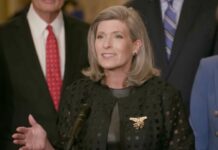The U.S. Supreme Court will hear oral arguments on Monday regarding a Denver-area website designer subject to a Colorado state law that censors and coerces the speech of creative professionals whose religious beliefs do not conform to state accepted beliefs.
Liberty Counsel filed an amicus brief to the High Court in 303 Creative v. Elenis in support of the free speech of Colorado native Lorie Smith. Senior Counsel for Governmental Affairs Jonathan Alexandre will speak at the rally in front of the Supreme Court steps at 9:30 a.m. before the oral arguments.
Smith creates unique and beautiful websites for her clients and started her business in 2012 to exercise creative freedom. Smith serves everyone but cannot use her design skills and creativity to express messages that violate her deeply held religious beliefs. However, under Colorado’s Anti-Discrimination Act, Smith could be punished simply for offering to create websites only celebrating weddings consistent with her beliefs that marriage is between one man and one woman.
In addition, the law acts as a gag order that prevents Smith from expressing on her website the reasons why she only creates messages celebrating certain ideas. Ironically, Colorado’s public-accommodation law allows secular artists but not religious ones like Smith to make “message-based refusals.”
Smith filed a lawsuit in 2016 in federal court. Nearly three years later, a judge issued a final ruling allowing Colorado officials to force Smith to design and publish websites promoting messages that conflict with her religious beliefs. In July 2021, the Court of Appeals ruled the state can force an artist to create expressive content, even if that speech violates their faith.
In the amicus brief, Liberty Counsel presents the fact that artistic expression is pure speech that is fully protected by the First Amendment and must be protected from censorship or compulsion, particularly when the message is an unpopular one. This applies even when speakers are compensated for artistic expression. The protected artistic expression includes, among other things, books, plays, films, video games, music, painting, poetry, drawings, engravings, sculptures and photography. This also includes website creation and content as pure speech since websites can provide a powerful way for private citizens to make their voices heard.
An example of a theatrical production that conveys thought-provoking messages is Michael Frayn’s “Copenhagen,” a fictional account of an actual meeting during World War II, in which two physicists share heated words and profound thoughts about the controversial development of the atom bomb. One of the men is a scientist who is attempting to harness the power of the atom for use by Germany, and the other scientist speaks from the perspective of a Danish citizen whose country has been taken over by the Third Reich.
In the brief, Liberty Counsel also includes the fact that books have often stirred emotions, made political statements, or sought to influence culture. Arthur Miller wrote “The Crucible” in 1953 responding in large part to the threat to civil liberties presented by those attempting to uncover communists in America. Realizing he could not write directly on the topic, he used the Salem witch trials as the backdrop to sound the alarm. As the film was being made in the mid-1990s, Mr. Miller explained that “so many practices of the Salem trials were similar to those employed by the congressional committees…”
Music also constitutes pure speech and musicals, as plays, often express societal or political messages. Like classical music, paintings convey messages, even when they contain no words. Although people may draw different meanings from the paintings, they undisputedly are protected speech according to the High Court. For example, painter Marc Chagall, known as “the quintessential Jewish artist of the 20th century, and one of the foremost visual interpreters of the Bible,” has explained that the “Bible is like an echo of nature and this secret I have tried to transmit.” His La Bible project spanned more than two decades and included 105 etchings in the series. As with any pictorial depiction of a literary piece, people will ascertain different meanings from the paintings and see the works of art from their unique perspective.
The Supreme Court also has noted that the First Amendment draws no distinction between the creation, the distribution, or the consumption of the speech at issue. For example, in Fields v. City of Philadelphia, the High Court ruled that “the First Amendment protects actual photos, videos, and recordings, and for this protection to have meaning the Amendment must also protect the act of creating that material.” The High Court also acknowledged that creating wedding videos involved several actions that individually might constitute conduct, such as “positioning a camera, setting up microphones, and clicking and dragging files on a computer screen” – but what was constitutionally significant was that the finished videos “are ‘media for the communication of ideas.’”
Liberty Counsel Founder and Chairman Mat Staver said, “The First Amendment protects creative expression, and the state cannot force individuals to convey a government-approved message. Film, theater, art, and other expressive creative expression would not exist if the government could censor the message.”
















